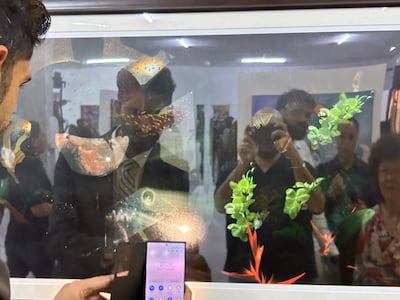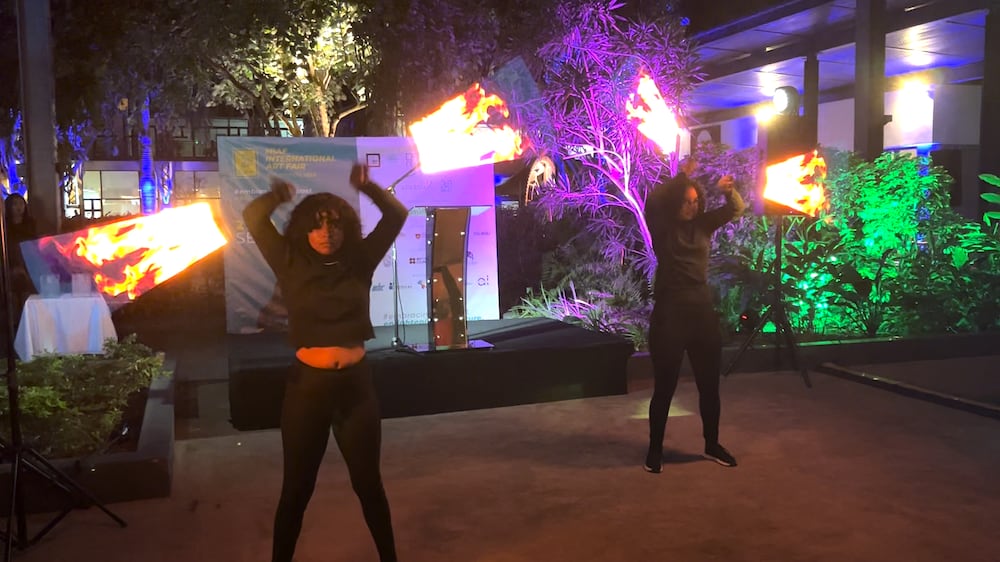The Mauritius International Art Fair has launched its third iteration, marking the conclusive run of the annual event that will instead return as a triennial to encompass neighbouring islands.
At the cusp of this new beginning, the fair’s theme is opportune. Taking place until Saturday at the Vivea Business Park in Moka Smart City, the event is being held under the banner Embracing our Past – Enlightening our Future.
“I think we have reached a point where we want to rebrand and grow, and also invite the other islands in the Indian Ocean,” says Zaahirah Muthy, director of Miaf and founder of its Dubai organising body ZeeArts.
“We have Madagascar, Seychelles, Reunion Island, as well as Comoros. I would like to welcome them to join forces and grow as a full ecosystem. We want to do a triennial, where we will tour between the five islands, not just Mauritius.”
Mauritius is a well-known tourist and wedding destination, famous for its picturesque landscapes that spans lush sugarcane fields, jagged mountain ranges and sandy beaches decorated naturally with volcanic rocks. However, Muthy says the country has so much more to offer, particularly in the cultural sense.
“We have great artists,” she says. “When I say artists, I’m also talking about the singers, musicians and the theatre. We have great stories from our history and heritage.”
Through the fair, Muthy says she has aimed to bring audiences to Mauritius to experience the country and its culture. Through the triennial, she hopes to empower that mission by including the other islands.
Miaf’s vernissage was held on Wednesday in the outdoor area of the Vivea Business Park. The venue – once a sprawling sugarcane factory – was transformed into a bustling address of creativity. Dancers performed the sega, a traditional Mauritian dance that has its origins in the ritual music of East Africa, as they led a procession towards the fair’s indoor exhibition space.
The exhibition is presenting more than 100 artworks across three pavilions. While one is dedicated exclusively to artists from Mauritius, the other two highlights work by regional and international artists. Miaf’s theme has prompted the participating artists from more than 30 countries to reflect on personal and collective pasts, while looking forwards with a degree of active optimism.

The opening artwork of the exhibition is Ghanaian artist Stephen Abban Junior’s Sika Dwa Kofi, or The Golden Stool. The work presents a child retaliating against a soldier, aided by a pair of birds that are disarming the man of his rifle and pistol. The scene is an arresting one, made all the more impressive as it was rendered with ink, acrylic and soil on burlap.
Mauritian artist Aungnoo Chiranjiv Mahesh Kumar, meanwhile, is showing a sculptural piece that offers a unique take on how to present photographs. A large film roll composed of illuminated panels, fotografi features pointillistic portraits of Mauritians that seem three-dimensional.
Another local artist featured is Jaikel Galante. A sculptor who enjoys fusing disparate materials in his work, Galante is presenting a work made of concrete, bicycle chains and iron that reflects upon the history of slavery in Mauritius, which began as the Dutch brought people from Africa onto the island to force them to labour in its plantations.

“I usually use fiberglass, wood, and iron in other works,” Galante, who is exhibiting at Miaf for the second time, says. “This is only my second time working with concrete.”
Zelime Juliette Marie-Cecile from Seychelles is showing a photographic collage that captures the fair’s temporal theme. Photographs of flora indigenous to Seychelles are superimposed on a scene of a spaceship. Almost pitch-black, Marie-Cecile advises viewers to approach the work with their phones’ touch lights, in order to reveal its contents entirely.
“I find it too practical to use what we usually see. I feel happier when I mix things together, to bring a new concept forward,” Marie-Cecile says. “This one is about creating a new ecosystem for the future. It is preserving national plants found in Seychelles in a spaceship. It’s to preserve a past for the future.”

It is the second time Marie-Cecile is participating in Miaf, a platform that she says helps up-and-coming artists from the region shine and present their works. “It’s getting bigger,” she says. “Last year, I presented a sculpture and wanted to do something different this year.”
Another work that responds to the fair’s theme with a perspective that is unique to the region is Trivy Daniel’s Flying to the Moon. The artist, who is from Reunion Island, utilises the Dodo to project a hopeful future. The bird went extinct in the 17th century following Dutch colonialism. Their extinction is attributed to deforestation and hunting as well as the animals that the Dutch brought to the island, which destroyed Dodo nests.
In Flying to the Moon, Daniel evokes the rebirth of the bird, showing it rise out of the fires of the past in phoenix-like fashion and soaring towards a futuristic city encapsulated in an orb.
“I began with ink to create movement, and added a person’s visage in the background, caught in between the past that’s burning and then the Dodo is in the foreground, flying to a better world,” Daniel says.

An arresting take on portraiture comes in the oil painting From the Source by Max Andre from Rodrigues Island. The painting features a woman in a straw hat and chequered shirt, smiling with an octopus in hand. The painting reflects on octopus fishing, which Andre says is predominately undertaken by women in his native island.
“For the theme of Miaf, I wanted to show the youth. I was thinking of the theme when I met her,” Andre says of his subject. “She was by the shore and had just come from fishing. I asked to take photographs of her, which I used as reference for the painting.”
The painting’s backdrop, a marbled yellow, blue and white pattern that adds to its three-dimensional feel but is also an homage to Rodrigues Island, Andre says.
“These are the colours I see every day,” he says. “Living on a tropical island, these are the colours that I feel talk to me.”

While art from Mauritius and its surrounding islands represent a major focal point of the fair, there are also several works from across the world, including Germany, Syria, Kosovo, Rwanda, Namibia and the UAE, which is represented by Eng Suaad Alshamsi.
The event at Vivea Business Park is only one aspect of Miaf, with other facets aiming to honour legacy artists in Mauritian culture, as well as educating and empowering the future generation.
The art fair is also paying special tribute to the established artists in Mauritius who have recently died. The exhibition, held in Moka’s Eureka House, features the works of Tristan Breville, Said Aniff Hossanee, Vaco Baissac and Roger Charoux.
Meanwhile, the conference aspect is aiming to underscore how art can be a viable investment platform and help boost the economy through the creative sector. Several Mauritian and international experts are taking part in panel discussions. These include two figures from the UAE, namely Meagan Kelly Horsman, managing director of Christie's Middle East, and Nisreen Bajis, an art collector and founder of the Abu Dhabi concept cafe Mysk.
Through Little Picasso, the fair is welcoming children from poverty-stricken communities within Mauritius to take part in art workshops while providing meals. ZeeArts founder Muthy has introduced the programme in several countries, including Lebanon, Bangladesh and Dubai. However, the event in Mauritius, Muthy’s native country, has a special place in her heart.
“On Saturday, we are bringing children from those pockets of poverty where they don’t have access to art to learn how to paint their dreams,” she says. “They will also have a proper lunch with a balanced diet. Everything starts with a dream and when you hang your dream on a wall, you’re reflecting on them.”
As a Mauritian, Muthy says she hopes the fair and the upcoming triennial will help empower the local creative economy and inspire the government to extend its support. Having worked on projects around the world, including several in the UAE, Muthy says she is trying to bring those learnt experiences back home to share its stories on a global platform while boosting the country’s well-being.
“I'm a product of Mauritius, so I feel proud to bring those knowledge and experience back to the island,” she says. “I really hope that the government takes this seriously and see the vision of what we're trying to do.”







